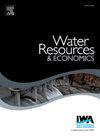2015年韩国干旱期间的节水补贴
IF 1.9
3区 经济学
Q2 ECONOMICS
引用次数: 0
摘要
为了解决2015年韩国干旱造成的水资源短缺问题,韩国水务局(K-water)在2015年10月至2016年1月期间实施了节水补贴。这一政策通过向家庭提供与去年同期相比节省的每单位水的回扣来激励减少的消费。补贴率为1240韩元/立方米(≈1.10美元/立方米),大约是大多数城市第一个街区水费的2.5-3倍。这项研究试图衡量干预措施的有效性,并发现它产生了大约4%-6%的用水量减少。我们发现,用水量相对较多的家庭(基线用水量的第3和第4四分位数)的用水量减少了6.1%,而用水量相对较少的家庭(第1四分位数)的用水量减少了4%。有趣的是,几乎没有证据表明财产价值会影响干预后用水量的减少。本文章由计算机程序翻译,如有差异,请以英文原文为准。
Water savings subsidy during 2015 drought in Korea
To address water shortages arising from the 2015 drought in Korea, the water authority (K-water) implemented a water savings subsidy between October 2015 and January 2016. This policy incentivized reduced consumption by offering households a rebate for each unit of water saved compared to the same month in the previous year. The rate of subsidy was 1240 KRW/m3 ($1.10/m3) which was roughly 2.5–3 times larger than the water rate for the first block in most of municipalities. This study attempts to measure the effectiveness of the intervention and finds that it generated a roughly 4%–6% reduction in water use. We find that households consuming relatively more water (3rd and 4th quartiles in terms of baseline water consumption) reduced their use by 6.1% but households consuming relatively less water (1st quartile) reduced their use by 4%. Interestingly, there is little evidence that property value affects the reduction in water use with the intervention.
求助全文
通过发布文献求助,成功后即可免费获取论文全文。
去求助
来源期刊

Water Resources and Economics
Environmental Science-Water Science and Technology
CiteScore
5.00
自引率
0.00%
发文量
17
审稿时长
51 days
期刊介绍:
Water Resources and Economics is one of a series of specialist titles launched by the highly-regarded Water Research. For the purpose of sustainable water resources management, understanding the multiple connections and feedback mechanisms between water resources and the economy is crucial. Water Resources and Economics addresses the financial and economic dimensions associated with water resources use and governance, across different economic sectors like agriculture, energy, industry, shipping, recreation and urban and rural water supply, at local, regional and transboundary scale.
Topics of interest include (but are not restricted to) the economics of:
Aquatic ecosystem services-
Blue economy-
Climate change and flood risk management-
Climate smart agriculture-
Coastal management-
Droughts and water scarcity-
Environmental flows-
Eutrophication-
Food, water, energy nexus-
Groundwater management-
Hydropower generation-
Hydrological risks and uncertainties-
Marine resources-
Nature-based solutions-
Resource recovery-
River restoration-
Storm water harvesting-
Transboundary water allocation-
Urban water management-
Wastewater treatment-
Watershed management-
Water health risks-
Water pollution-
Water quality management-
Water security-
Water stress-
Water technology innovation.
 求助内容:
求助内容: 应助结果提醒方式:
应助结果提醒方式:


